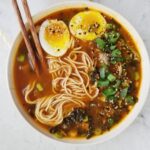Embark on a culinary journey through Italy, reimagining beloved classics without compromising on flavor or authenticity. This exploration delves into the art of crafting soy-free Italian dishes, revealing the secrets to maintaining traditional tastes while cleverly substituting ingredients. From vibrant pasta sauces bursting with fresh herbs to the golden-brown crust of a perfectly baked focaccia, we’ll uncover the techniques and recipes that transform familiar favorites into delightful, soy-free masterpieces. Prepare to be inspired by the vibrant colors, enticing aromas, and rich textures that define this delicious culinary adventure.
Discover how easily adaptable traditional Italian recipes are, showcasing the versatility of classic techniques. We’ll explore common soy-based ingredients and their readily available replacements, ensuring that every dish retains its unique character and satisfying depth of flavor. Learn to create stunning presentations, transforming simple meals into works of art, each bite a testament to the beauty of Italian cuisine, now perfectly suited for those with soy sensitivities or preferences.
Authentic Italian Flavors, Soy-Free
Embark on a culinary journey through Italy, where vibrant flavors and time-honored traditions meet the demands of a soy-free diet. This exploration reveals how to maintain the authenticity of Italian cuisine while expertly navigating the absence of soy. Discover the simple substitutions and techniques that preserve the heart and soul of Italian cooking, creating dishes that are both delicious and inclusive.
Traditional Italian Techniques Adapted for Soy-Free Cooking
Traditional Italian cooking relies heavily on fresh, high-quality ingredients and simple preparation methods that allow the natural flavors to shine. These techniques translate beautifully to soy-free cooking. The emphasis remains on using fresh herbs, ripe tomatoes, fragrant garlic, and high-quality olive oil. Slow cooking methods, such as braising and simmering, allow flavors to meld and deepen, creating rich and complex sauces without relying on soy-based thickeners. The art of making fresh pasta from scratch, a cornerstone of Italian cuisine, remains entirely soy-free.
Common Soy-Based Ingredients and Their Soy-Free Alternatives
Several ingredients commonly found in some modern interpretations of Italian food contain soy. Understanding these and their replacements is key to authentic soy-free cooking.
| Soy-Based Ingredient | Soy-Free Alternative | Example |
|---|---|---|
| Soy Sauce | Coconut aminos, tamari (gluten-free varieties available), fish sauce (for seafood dishes) | Use coconut aminos in stir-fries or marinades. |
| Soy Lecithin | Sunflower lecithin | Found in some processed foods; replace with sunflower lecithin where possible. |
| Soy Milk | Dairy milk, almond milk, oat milk (depending on the recipe) | Dairy milk in creamy sauces, almond milk in desserts. |
| Textured Vegetable Protein (TVP) | Mushrooms, lentils, chickpeas, finely chopped vegetables | Use lentils or mushrooms as a meat substitute in ragu. |
The Importance of High-Quality Ingredients
The cornerstone of authentic Italian cuisine is the unwavering commitment to high-quality, fresh ingredients. This principle becomes even more crucial when adapting recipes to be soy-free. Using superior ingredients – ripe tomatoes bursting with sweetness, fragrant basil leaves, and robust olive oil – allows the natural flavors to take center stage, compensating for any perceived lack of soy-based flavor enhancers. The richness and complexity of the ingredients themselves become the star of the show. Consider the difference between a sauce made with canned tomatoes versus a sauce made with freshly picked, sun-ripened tomatoes. The superior quality of the ingredients immediately elevates the final dish.
Traditional Italian Recipes and Their Soy-Free Counterparts
The transition to soy-free Italian cooking is surprisingly straightforward. Many classic recipes are inherently soy-free, requiring only mindful ingredient substitutions in others.
| Traditional Recipe | Soy-Free Adaptation | Ingredient Substitution | Notes |
|---|---|---|---|
| Pasta Aglio e Olio | Pasta Aglio e Olio (Soy-Free) | None needed | This classic is naturally soy-free. |
| Marinara Sauce | Marinara Sauce (Soy-Free) | Replace soy sauce (if used) with coconut aminos or tamari. | Ensure your canned tomatoes do not contain added soy. |
| Risotto Milanese | Risotto Milanese (Soy-Free) | Check for soy lecithin in saffron. Use a high-quality saffron brand. | This risotto is typically soy-free. |
| Chicken Parmesan | Chicken Parmesan (Soy-Free) | Ensure breading doesn’t contain soy lecithin. | Use panko breadcrumbs or make your own. |
Popular Soy-Free Italian Dishes
Savoring authentic Italian cuisine doesn’t require soy! Many beloved dishes are naturally soy-free, or easily adaptable to exclude it, allowing you to enjoy the vibrant flavors without compromise. Below, we explore five popular Italian dishes, providing detailed, soy-free recipes and vivid descriptions of their presentation.
Spaghetti Aglio e Olio
This classic showcases the beauty of simplicity. The rich garlic flavor, the peppery bite of chili flakes, and the bright vibrancy of the olive oil are all stars in this show. Soy is entirely absent from the traditional recipe.
- Heat extra virgin olive oil in a large pan over medium heat.
- Add minced garlic and red pepper flakes; sauté until fragrant (about 1 minute), being careful not to burn the garlic.
- Add cooked spaghetti and toss to coat evenly with the oil and garlic mixture.
- Stir in freshly grated Parmesan cheese and chopped fresh parsley.
- Serve immediately. The plating is simple yet elegant: a mound of spaghetti in a shallow bowl, glistening with olive oil, the bright green of the parsley contrasting with the golden yellow of the pasta and the white of the cheese.
Marinara Sauce with Fresh Pasta
A rich and flavorful marinara sauce, made with fresh tomatoes, garlic, herbs, and a touch of sweetness, pairs perfectly with homemade pasta. This is naturally soy-free.
- Sauté minced garlic and finely chopped onion in olive oil until softened.
- Add crushed or diced fresh tomatoes, oregano, basil, and a pinch of sugar. Simmer for at least 30 minutes, allowing the flavors to meld.
- Season with salt and pepper to taste.
- Serve over your favorite fresh pasta. The plating could feature a vibrant red sauce generously coating the pasta, with a sprinkle of fresh basil adding a pop of green. The warm, inviting colors and rustic simplicity are appealing.
Chicken Saltimbocca
This classic Roman dish is naturally soy-free, relying on the delicate interplay of chicken, prosciutto, sage, and white wine.
- Pound chicken breasts to an even thickness.
- Top each chicken breast with a slice of prosciutto and a sage leaf.
- Sear the chicken in butter until golden brown on both sides.
- Deglaze the pan with dry white wine, allowing it to reduce slightly.
- Serve immediately. The presentation could be elegant: thinly sliced chicken breasts, glistening with the reduced wine sauce, nestled amongst a bed of creamy polenta or simply served with a side of roasted vegetables. The contrasting colors and textures create visual interest.
Osso Buco
This braised veal shank is a rich and flavorful dish. Traditional recipes do not include soy.
- Sear veal shanks in olive oil until browned on all sides.
- Add finely chopped onion, carrots, and celery to the pot and sauté until softened.
- Add white wine, broth, and tomatoes. Season generously with salt, pepper, and herbs like rosemary and thyme.
- Simmer until the veal is very tender (at least 2-3 hours).
- Serve with gremolata (a mixture of parsley, lemon zest, and garlic). The plating could highlight the tender, falling-apart veal shank, surrounded by the rich, deeply colored braising liquid. A sprinkle of bright green gremolata adds a fresh, contrasting element.
Caprese Salad
A simple yet stunning salad, the Caprese is naturally soy-free and showcases the fresh flavors of Italy.
- Slice fresh mozzarella, ripe tomatoes, and fresh basil leaves.
- Arrange the slices alternately on a plate, creating a visually appealing pattern.
- Drizzle with extra virgin olive oil and balsamic glaze.
- Season with salt and freshly ground black pepper. The plating is simple elegance: the bright red of the tomatoes, the creamy white of the mozzarella, and the deep green of the basil leaves create a vibrant, refreshing image. The dark balsamic glaze adds a touch of sophistication.
Recipe and Step-by-Step Guide

This recipe delivers a truly authentic Spaghetti Carbonara, free from soy and bursting with rich, creamy flavor. We’ll achieve that classic texture using simple, traditional methods, focusing on the perfect emulsification of egg yolks, cheese, and pasta water. Get ready to experience the magic of a perfectly executed Carbonara.
Ingredients
This recipe serves two. Precise measurements are less important than the balance of flavors; feel free to adjust to your preference.
- 8 ounces spaghetti, preferably a high-quality bronze-die pasta for superior texture.
- 4 large egg yolks, at room temperature for optimal emulsification.
- 1/2 cup Pecorino Romano cheese, finely grated. The sharp, salty bite is essential.
- 1/4 cup freshly grated Parmesan cheese, adding a milder counterpoint to the Pecorino.
- 4 ounces guanciale, diced. Pancetta can be substituted, but guanciale provides the most authentic flavor. Imagine its rich, salty, slightly sweet aroma.
- Freshly ground black pepper, to taste. Generous amounts are traditional and enhance the richness.
- Salt, for the pasta water.
Preparing the Guanciale
The rendering of the guanciale is crucial for building flavor. A large skillet over medium heat is ideal. The diced guanciale, initially pale and firm, gradually transforms. Imagine the fat rendering, turning translucent and golden-brown, while the meat crisps to perfection. This slow rendering process infuses the fat with incredible depth of flavor. Once rendered, remove the guanciale, leaving the rendered fat in the pan.
Cooking the Pasta
Bring a large pot of generously salted water to a rolling boil. The water should taste like the sea. Add the spaghetti and cook according to package directions, aiming for *al dente*. Picture the pasta, firm yet yielding to the bite, not mushy or overcooked. Reserve about 1/2 cup of the starchy pasta water before draining. This starchy water is key to creating the creamy sauce.
Creating the Creamy Sauce
In a large bowl, whisk together the egg yolks, Pecorino Romano, and Parmesan cheese until smooth and creamy. The mixture should be pale yellow, almost luminous. Slowly drizzle in a few tablespoons of the reserved pasta water, whisking constantly to temper the eggs and prevent scrambling. This creates a smooth, emulsified base.
Combining and Serving
Add the drained pasta to the cheese mixture. Toss quickly to coat. Then, add the rendered guanciale fat and the crispy guanciale pieces. Toss gently to combine. The residual heat from the pasta will gently cook the eggs, creating a luscious, creamy sauce. If the sauce seems too thick, add more pasta water, a tablespoon at a time, until you reach the desired consistency. Finally, generously season with freshly ground black pepper. Serve immediately. Imagine the glistening strands of pasta, coated in a creamy, decadent sauce, dotted with crispy guanciale, a perfect culinary symphony.
This culinary exploration has showcased the remarkable adaptability of Italian cuisine, proving that delicious, authentic flavors can thrive without soy. From the creamy richness of a soy-free carbonara to the sun-drenched vibrancy of a tomato-based pasta sauce, we’ve demonstrated that careful ingredient substitutions and precise techniques can elevate any dish. Embrace the creativity and passion of Italian cooking, and embark on your own culinary journey, crafting soy-free masterpieces that will delight your senses and impress your guests. The vibrant colors, aromatic herbs, and satisfying textures await – savor the experience!
Clarifying Questions
Can I freeze soy-free Italian dishes?
Yes, many soy-free Italian dishes freeze well. Allow them to cool completely before freezing in airtight containers for optimal quality.
What are some good soy-free alternatives to soy sauce?
Coconut aminos, tamari (ensure it’s wheat-free if needed), or a combination of herbs and spices can effectively replace soy sauce in many Italian recipes.
Are all Italian cheeses soy-free?
Most traditional Italian cheeses are naturally soy-free. However, always check labels to ensure there are no added ingredients.
How can I make my soy-free pasta sauces even more flavorful?
Experiment with different herbs, spices, and a touch of red pepper flakes to add depth and complexity to your sauces.


